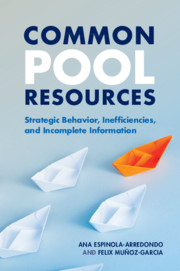Book contents
- Frontmatter
- Contents
- List of Figures
- List of Matrices
- Preface
- 1 Introduction
- 2 Common Pool Resources in a Static Setting
- 3 Common Pool Resources in a Dynamic Setting
- 4 Entry Deterrence in the Commons
- 5 Repeated Interaction in the Commons
- 6 Commons under Incomplete Information
- 7 Signaling in the Commons
- Appendix A Game Theory Tools
- Appendix B Solutions to Selected End-of-Chapter Exercises
- Bibliography
- Index
2 - Common Pool Resources in a Static Setting
Published online by Cambridge University Press: 03 August 2023
- Frontmatter
- Contents
- List of Figures
- List of Matrices
- Preface
- 1 Introduction
- 2 Common Pool Resources in a Static Setting
- 3 Common Pool Resources in a Dynamic Setting
- 4 Entry Deterrence in the Commons
- 5 Repeated Interaction in the Commons
- 6 Commons under Incomplete Information
- 7 Signaling in the Commons
- Appendix A Game Theory Tools
- Appendix B Solutions to Selected End-of-Chapter Exercises
- Bibliography
- Index
Summary
INTRODUCTION
In this chapter, we start our analysis of CPRs from a stylized setting, namely, a one-shot interaction between the agents exploiting the resource, such as the fishermen operating in a fishing ground. This is, of course, a simplifying assumption, since a key feature of CPRs is that an initial stock can be depleted over time. Such depletion affects the intensity with which agents exploit the resource in each period, which we will examine in future chapters. By abstracting from the dynamic aspects of the CPR, however, we gain a clearer understanding of the incentives that agents face within a period, and which are not driven by the stock depletion.
We first investigate appropriation in a CPR such as a fishing ground, a forest, or an aquifer, e.g., how many tons of fish each fishing boat catches.We analyze how this appropriation is affected by the available stock and the number of agents exploiting the resource. Section 2.3 then identifies the socially optimal appropriation of the resource and how it differs from the equilibrium appropriation that agents choose when left unregulated. Section 2.4 elaborates on policies commonly used to induce these agents to exploit the CPR at a socially optimal level.
MODELING THE CPR
Assume that N firms (or individuals) have free access to the resource. Every unit of appropriation (e.g., a ton of fish) is sold in the international market that, for simplicity, is assumed to be perfectly competitive. Intuitively, every fisherman's appropriation (e.g., 20 tons of cod) represents a small share of industry catches, thus not affecting market prices for this variety of fish. As a result, every firm takes the market price pas given, whichwe normalize to p= $1 to facilitate our analysis. (We examine how our results are affected by this assumption in Subsection 2.3.2.)
Cost Function: In addition, every firm faces the following cost Function
where S > 0 denotes the stock of the resource, which reduces fisherman i 's cost when the resource becomes more abundant (intuitively, fish are easier to catch).
Information
- Type
- Chapter
- Information
- Common Pool ResourcesStrategic Behavior, Inefficiencies, and Incomplete Information, pp. 7 - 33Publisher: Cambridge University PressPrint publication year: 2021
